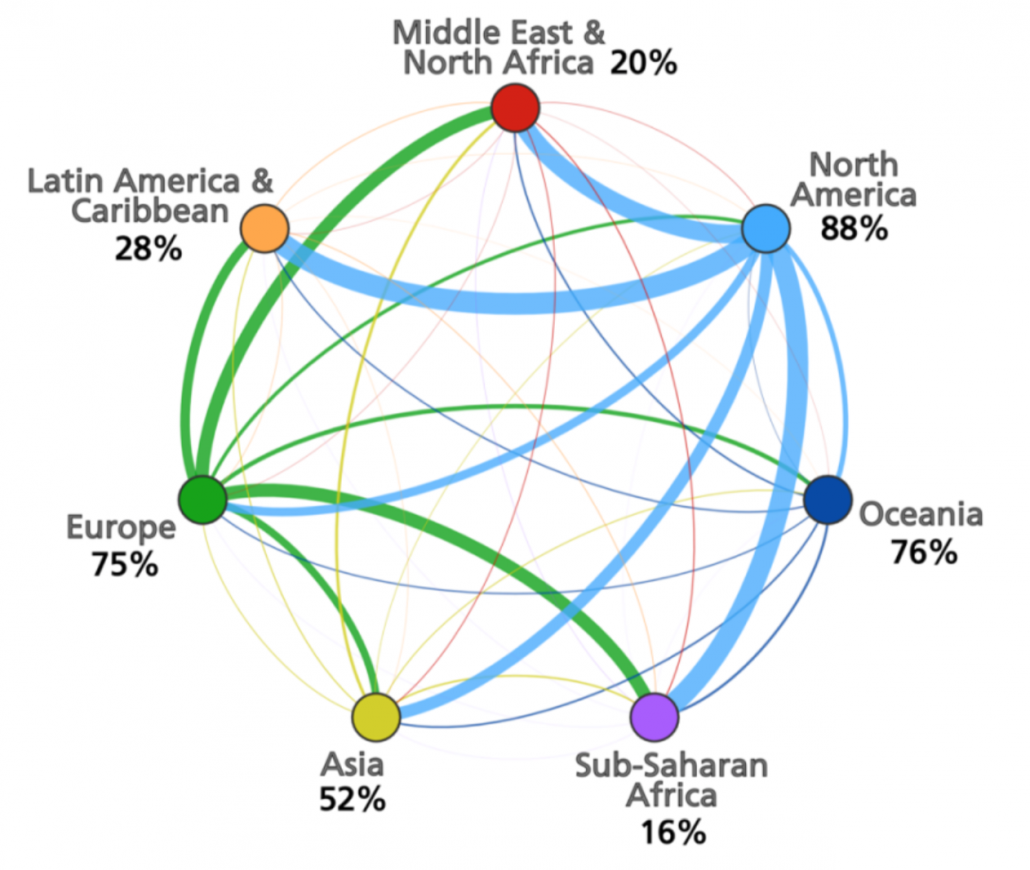The previous posts about the geography of contributions to Wikipedia showed the varying types of local engagement that different regions have, the primary reason that Sub-Saharan Africa, in particular, has such a low proportion of locally created content, and some of the ways that Sub-Saharan Africa’s already extremely low proportion of local contributions is inflated by just a few outliers (meaning that the vast majority of content written about countries in Sub-Saharan Africa is created from outside the region).
In all of that work, we employed a simplified distinction of ‘within region’ or ‘outside region’ when considering the geography of edits. However, it is possible to also look at which regions send edits to which other regions. Thus, instead of a univariate map or a bivariate scatter plot, we can represent the data as a network of flows.

Network of Wikipedia edits between world regions, normalised for each target region. The edges are coloured according to the source region. Percentages denote self-edits (not depicted).
(graphic by Ralph Straumann – in Graham, M., and Hogan, B. 2014. Uneven Openness: Barriers to MENA Representation on Wikipedia. Oxford Internet Institute Report, Oxford UK.)
The network above is just such an attempt. In it, edge (a line connecting nodes) thickness is proportionate to the total number of edits received. That is, if a region receives most of its edits from North America then the edge from North America to that region will be thick.
When looking at flows of geographic information, there are “net-importing” regions (Asia, Latin America & Caribbean, Middle East & North Africa, and Sub-Saharan Africa) and “net-exporting” regions (North America, Oceania) in terms of edits. Sub-Saharan Africa receives 10.7 more edits from outside than it commits to the outside. North America, in contrast has a figure of 0.38.
The next post will look at the data somewhat differently. Instead of where edits are received from, it will focus on where edits are sent to (as we shall see, this is an important difference).
Note that this work comes from the following report (the relevant parts of which were written in collaboration with Ralph Straumann and Bernie Hogan):
Graham, M., and Hogan, B. 2014. Uneven Openness: Barriers to MENA Representation on Wikipedia. Oxford Internet Institute Report, Oxford UK.
The following paper also offers an abridged version of some of the results:
Graham, M., Hogan, B., Straumann, R. K., and Medhat, A. 2014 Uneven Geographies of User-Generated Information: Patterns of Increasing Informational Poverty Annals of the Association of American Geographers (forthcoming).
Or for a broader discussion about why the locality of participation matters, see:
Graham, M. 2014. Internet Geographies: Data Shadows and Digital Divisions of Labour. In Society and the Internet: How Networks of Information and Communication are Changing our Lives, eds M. Graham and W. H. Dutton. Oxford: Oxford University Press. 99-116.
Graham, M., M. Zook, and A. Boulton. 2013. Augmented Reality in the Urban Environment. Transactions of the Institute of British Geographers. 38(3) 464-479.